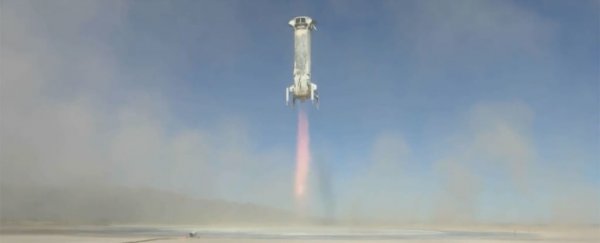Jeff Bezos' spaceflight company Blue Origin just scored an impressive double victory, aceing an experimental safety manoeuvre that could in a few years save the lives of human passengers travelling into space.
The test for Blue Origin's New Shepard rocket on Wednesday actually involved two launches – and two landings – and the fact that both touchdowns succeeded surprised even Bezos himself, who in the lead-up expressed doubt over whether the rocket's booster would survive.
The purpose of the exercise was to see if New Shepard's in-flight escape system worked, and based on its first test at a launchpad in West Texas, it's a big thumbs up.
The idea is that, in the event of an anomaly during the launch sequence that could endanger any passengers on board, the crew capsule separates from the booster – mid-launch, mind you – with an escape motor thrusting the passenger module away from the rocket.
It sounds kind of dramatic, and even with a crew-less capsule in yesterday's test, it looks dramatic too:

You can see the escape system in operation above, although unless you're a total enthusiast, you may want to skip ahead to 51:15, where the countdown begins and the amazing stuff kicks off.
About 45 seconds after the successful launch, at an altitude of close to 5,000 metres (16,000 feet) – with New Shepard travelling skywards at a phenomenal 766 kilometres per hour (476 miles per hour) – the escape system is activated, and the crew capsule can be seen bursting from the rocket.
You can relive this exciting moment (endlessly, if you wish) in this Vine from Bezos:
While the booster continues upwards, stabiliser thrusters steady the capsule, before three parachutes are deployed to slow its descent and safely bring it to a landing.
After that comes the bit that Bezos himself didn't see coming – the booster, having reached its altitude peak, begins to re-enter the atmosphere. At about 58:30, it fires its thruster, deploys its landing gear, and touches down safely on terra firma.
While the booster was designed to be re-usable in standard flights – which is the whole economic rationale of Blue Origin's vision for its rockets – the company never expected it to survive the fire and force of the crew capsule's own thrust.
Writing about the booster on the company's blog in September, Bezos explained:
"We'd really like to retire it after this test and put it in a museum. Sadly, that's not likely. This test will probably destroy the booster. The booster was never designed to survive an in-flight escape.
The capsule escape motor will slam the booster with 70,000 pounds [31,751 kilograms] of off-axis force delivered by searing hot exhaust. The aerodynamic shape of the vehicle quickly changes from leading with the capsule to leading with the ring fin, and this all happens at maximum dynamic pressure."
Luckily for everybody, the worst didn't come to pass, and the booster made it through the experimental procedure – which Bezos acknowledged was a slim possibility in his blog entry, although, quite frankly, it sounds like he was looking forward to either eventuality:
"Nevertheless, the booster is very robust and our Monte Carlo simulations show there's some chance we can fly through these disturbances and recover the booster…
In the more likely event that we end up sacrificing the booster in service of this test, it will still have most of its propellant on board at the time escape is triggered, and its impact with the desert floor will be most impressive."
(Emphasis added.)
But what's ultimately more important than the booster's survival in this instance is that the escape system itself works as planned.
While the capsule launcher would only ever be triggered in an emergency situation, seeing as the company intends to begin ferrying passengers into space in just two years' time, it's good to know all bases are being covered.
You can find out more about the escape system in the animation below:

